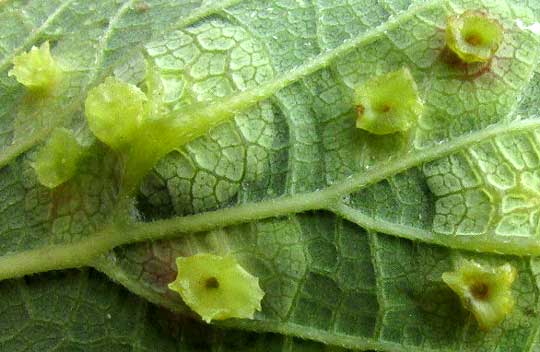Excerpts from Jim Conrad's
Naturalist Newsletter

from the July 27, 2014 Newsletter issued from the Frio Canyon Nature Education Center in the valley of the Dry Frio River in northern Uvalde County, southwestern Texas, on the southern border of the Edwards Plateau; elevation ~1750m (~5750 ft); N29.62°, W99.86°; USA
HACKBERRY BLISTER GALLS
Nowadays many of our Netleaf Hackberry trees bear leaves deformed with galls such as those shown above. A closer look showing better how in the center of each gall a slender, fingerlike projection arises is shown below.

Beneath the leaf, the galls have a different appearance, a seen below:

Back East we often saw Hackberry Nipple-Galls, but they were more columnar, made by a different insect. This one is called the Hackberry Blister Gall and it's produced by an aphid-size member of the insect order Hemiptera, and looks like a tiny cicada. It's PACHYPSYLLA CELTIDISVESICULA, sometimes called Jumping Plant Louse. According to Texas A&M AgriLife Extension's online field guide, hackberry galls are not considered to be harmful to the trees.
After adult Pachypsylla celtidisvesiculas mate in the spring, the females lay eggs on the underside of expanding hackberry leaves. Nymphs, which are juvenile stages of insects undergoing incomplete metamorphosis, hatch in about 10 days and begin feeding on their leaf, causing tumor-like growth among the leaf cells immediately around the feeding nymphs. The growth ultimately forms a pouch or gall surrounding the nymph, like those shown in our pictures. The nymph develops through several similar-looking but progressively larger stages, or instars, before during its last and largest nymphal stage -- just after its leaf has fallen in the fall -- it cuts a slit in its gall and emerges.
About half an hour after emergence, the nymph molts into an adult. Around house-trees whose leaves bore Hackberry Blister Galls, often large numbers of freshly emerged adults cluster on windows and door screens, settle onto the house's side, automobiles and hanging laundry, and stick to freshly applied paint. They don't do anything bad, other than just be where some people wouldn't welcome them, though I would find such emergences awe inspiring.
Adults overwinter in tree bark crevices, or just about any other protected spot. In the spring they fly to hackberry trees where they mate and start the cycle all over again.